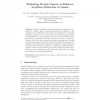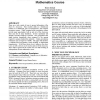45 search results - page 4 / 9 » How can human motion prediction increase transparency |
CVPR
2007
IEEE
14 years 8 months ago
2007
IEEE
We introduce novel discriminative learning algorithms for dynamical systems. Models such as Conditional Random Fields or Maximum Entropy Markov Models outperform the generative Hi...
MIG
2009
Springer
14 years 27 days ago
2009
Springer
Abstract. Realistic simulation of interacting virtual characters is essential in computer games, training and simulation applications. The problem is very challenging since people ...
CGF
2005
13 years 6 months ago
2005
Interactive control of a physically simulated character is a challenging problem, due both to the complexity of controlling multiple degrees of freedom with lower dimensional inpu...
BMVC
2002
13 years 8 months ago
2002
This paper presents novel methods for increasing the robustness of visual tracking systems by incorporating information from inertial sensors. We show that more can be achieved th...
SIGCSE
2004
ACM
13 years 11 months ago
2004
ACM
There are a wide variety of ways to present information at the front of a classroom. These include chalk on a blackboard, markers on a whiteboard, pens on transparencies, and comp...


